- HOME >
- How to choose quality tea
The Relationship Between Greenness of Tea Leaves and Fertilizer
- [2024.03.17] Posted By Akira Hojo
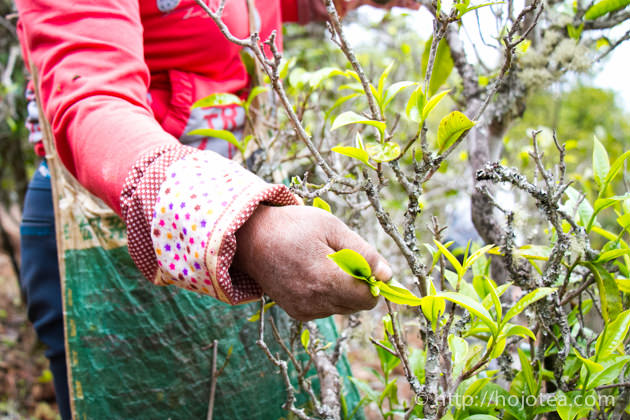
For both tea and vegetables, there’s a common misconception that a deeper green colour indicates better quality and greater health benefits. However, this isn’t always the case.
Natural plants often have a yellowish-green hue rather than a vibrant green.
If you observe wild plants in grasslands or along roadsides during spring, you’ll notice that they typically display a surprising yellow-green colour. Conversely, vegetables grown in cultivated fields exhibit a much richer, deeper green shade, making the field boundaries clearly visible even from a distance. When fertilizer is applied to grass in meadows, the previously yellowish-green vegetation transforms into a lush green, with the fertilized areas noticeably standing out and experiencing significant growth. Similarly, houseplants tend to appear yellowish-green when lacking nutrients, but they turn into a deep green when provided with adequate fertilization.
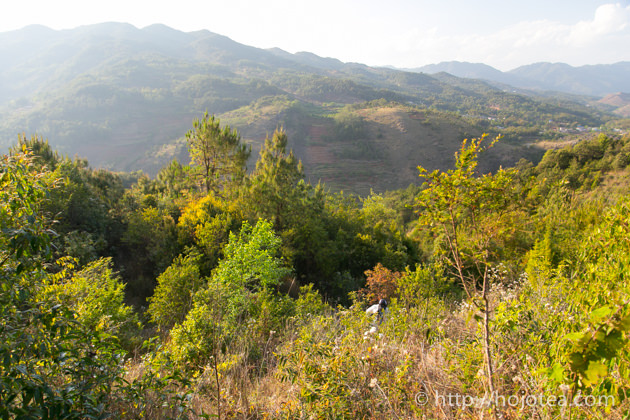
Tea cultivated without the use of fertilizers often results in smaller leaves with a yellowish-green tint.
This phenomenon is particularly evident in certain regions, such as remote mountain villages in Yunnan Province, where tea bushes are tended to in traditional ways. For the minority communities inhabiting these areas, tea isn’t something they actively cultivate; rather, it naturally thrives in the mountainous terrain. They only clear the undergrowth during the tea-picking season. Throughout the year, no pesticides, fertilizers, or pruning are applied, adhering to a farming method that can be described as simply leaving the tea plants untouched. In Japan, this method is known as natural farming, while in China, it’s referred to as “Sheng-tai Cha”. Tea produced through such methods typically exhibits smaller leaves and a yellow-green coloration.
This agricultural style has been practiced in Yunnan Province for several centuries; however, in recent years, such traditional tea gardens have been on the decline. As these regions gain fame, the demand for their teas surges, consequently driving up prices. In an effort to enhance income, farmers often resort to applying fertilizers, resulting in tea leaves taking on a deeper green hue. Additionally, this practice leads to an increase in leaf size and growth rate, resulting in a significant boost in harvest yield.
Tea gardens maintained in a natural, unattended manner without the use of fertilizers.
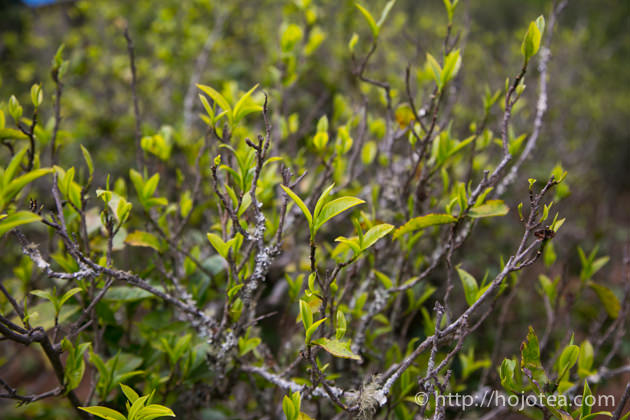
Naturally Cultivated Spinach Tends to Have a Yellowish-Green Color
Have you ever seen naturally cultivated spinach? When we think of spinach, we often picture a deep green colour, but spinach cultivated without nitrogen fertilizers surprisingly appears yellow-green. Specifically, we are referring to spinach grown in fields where fertilizers have not been used for over 7-8 years, allowing the soil to completely recover from the effects of fertilizers.
While I don’t have photos to share of naturally cultivated spinach, you can find various images by searching on platforms like Google using keywords such as “spinach” + “natural cultivation” or “spinach” + “no fertilizer.” Natural spinach might be overlooked due to its somewhat yellowish appearance, but its taste is incredibly rich with a sweet aftertaste, making it a memorable culinary experience once you try it.
Plants That Grow Rapidly Often Exhibit a Deep Green Colour
Plants in the natural environment are typically deficient in nitrogen, so when nitrogen fertilizers are added, they quickly absorb nitrogen. This rapid absorption prompts the plants to grow rapidly as well. Consequently, they synthesize chlorophyll, the green pigment responsible for photosynthesis, in abundance, turning into efficient photosynthetic factories. As a result, plants enriched with nitrogen exhibit a very deep green colour, and their leaf surfaces expand to efficiently absorb more light.
The image below shows an area that was once a naturally cultivated tea plantation until a few years ago. Due to the growing popularity of the region, it quickly transitioned into a site cultivated with fertilizers. Contrasting with the naturally cultivated tea plantation above, the tea leaves here are larger, darker in colour, and exhibit numerous surface irregularities. It is believed that plants develop surface irregularities on leaves to increase their surface area, facilitating easier absorption of light.

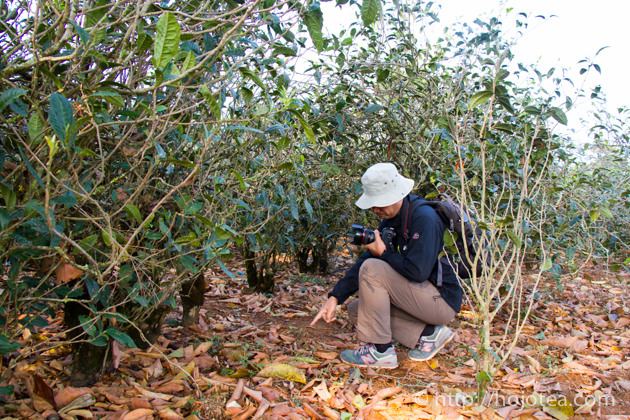

Rapid Growth Often Results in a Lighter Flavor
Fast-growing crops tend to produce less robust flavours naturally. This is comparable to aquaculture fish raised under accelerated growth conditions, where the tea’s rapid growth often yields a lighter flavor profile. Conversely, tea plants that mature at a slower pace develop firmer leaves and impart an exceptionally rich taste. The superior quality of high-mountain or old-growth tree tea is also attributed to this slower growth rate. When selecting tea, I prioritize gardens that have undergone a slower growth process. Conditions such as no fertilization, no pruning, high-altitude cultivation, old-growth trees, a more northerly latitude, and clayey soil contribute to a slower growth rate, resulting in tea of exceptional quality.
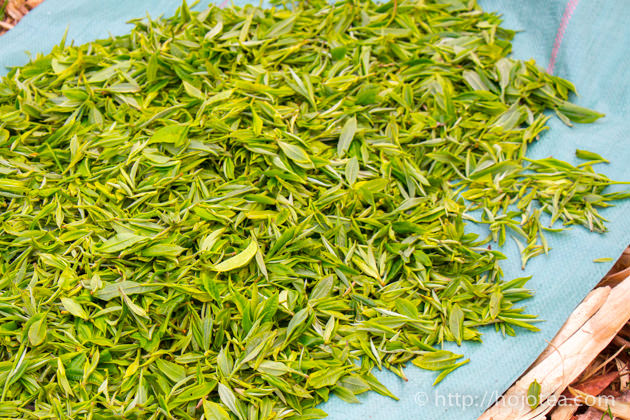
Tea produced without the use of fertilizers often exhibits a yellowish tint overall.
The Role of Magnesium in Chlorophyll and Its Impact on Taste
Chlorophyll, the green pigment in plants, contains magnesium within its molecular structure, along with nitrogen. Magnesium is known for its bitter taste. When magnesium interacts with water, it imparts a bitter and astringent flavor. As mentioned earlier, tea cultivated with fertilizers tends to contain higher levels of chlorophyll. During tea processing, when chlorophyll oxidizes, its molecules break down, releasing the magnesium contained within. While this is a hypothesis, it is possible that slightly oxidized green tea from conventional cultivation (fertilizer-based) may become excessively bitter due to the release of magnesium ions during chlorophyll oxidation and decomposition, impacting the tea’s taste.

In summary, a deep green colour typically signifies vigorous plant growth, often promoted by the use of fertilizer, whether organic or chemical. However, if you’re seeking a tea with a lingering aftertaste, richness, and depth of flavor, it becomes essential for tea leaves to display a yellowish-green hue rather than a vibrant green.
There are exceptions, though; for example, tea cultivated in shaded environments, even if it’s naturally farmed, tends to exhibit a deeper green colour. Due to the limited sunlight in shaded conditions, plants synthesize more chlorophyll, enhancing their ability to absorb sunlight efficiently. The photo above depicts naturally cultivated tea, albeit grown in a shaded area.
Related Articles
How to get the latest update on HOJO Tea?
1. Follow Twitter, 2. Click "Like" on Facebook, and 3. Subscribe in newsletter. You can have the latest tea news from HOJO Tea.
 Subscribe the Newsletter to enjoy the privileges
Subscribe the Newsletter to enjoy the privileges- You may receive a free sample upon purchase, or you may have the priority to purchase special products. So please remember to subscribe our newsletter as well as the social network.
- New Release of High Mountain White Tea
- We are pleased to introduce our High Mountain White Tea, sourced from a unique tea garden with two key features: 1. Located at an altitude of 2200-2300m2. Completely wild and untended The ideal natural conditions of this garden result in tea of exceptional quality, offering a pure and gentle, nourishing taste. High Altitude and Wild …
- New Release of Da Xue Shan Wild White Tea 2024
- We have released the 2024 Da Xue Shan Wild White Tea Loose Leaf. This tea was produced under our direct supervision during our stay in Yunnan Province, ensuring meticulous production management on site. Definition of Wild Tea in Yunnan Province People in Yunnan strongly associate Camellia taliensis with wild tea, regardless of where it is …
NEW ARTICLES
 Why Do Some Teas Taste Astringent? Exploring the Causes and Mechanisms of Astringency
Why Do Some Teas Taste Astringent? Exploring the Causes and Mechanisms of Astringency- Tea can range from having no noticeable astringency to possessing a very strong one. What causes this astringency? This article explores the causes and mechanisms behind astringency in tea. Causes of Astringency Astringency arises from the binding of tea components to proteins in the oral cavity, creating a sensation of tightness or dryness. The tongue …
 The Impact of Heat Sources on Tea Flavor
The Impact of Heat Sources on Tea Flavor- It is widely recognized that the material of a kettle plays an important role in shaping the taste of water for brewing tea. Yet, an often overlooked but equally significant factor is the type of heat source used to boil the water. Different heat sources, whether gas, electric, charcoal, or wood fire, can impart distinct …
 New Release of High Mountain White Tea
New Release of High Mountain White Tea- We are pleased to introduce our High Mountain White Tea, sourced from a unique tea garden with two key features: 1. Located at an altitude of 2200-2300m2. Completely wild and untended The ideal natural conditions of this garden result in tea of exceptional quality, offering a pure and gentle, nourishing taste. High Altitude and Wild …
 New Release of Da Xue Shan Wild White Tea 2024
New Release of Da Xue Shan Wild White Tea 2024- We have released the 2024 Da Xue Shan Wild White Tea Loose Leaf. This tea was produced under our direct supervision during our stay in Yunnan Province, ensuring meticulous production management on site. Definition of Wild Tea in Yunnan Province People in Yunnan strongly associate Camellia taliensis with wild tea, regardless of where it is …
 New Release of Wild Pu-erh Jasmine Pearl
New Release of Wild Pu-erh Jasmine Pearl- Out of curiosity, we decided to create a jasmine tea based on Da Xue Shan Wild Raw Tea. This resulted in an exceptionally rare tea, not only in Japan but also in China. Custom Production Network for Jasmine Tea At our store, we source various types of base teas from different regions during the spring. …
 2024 Overview: Our Yunnan White Tea Quality, Process, and Weather Insights
2024 Overview: Our Yunnan White Tea Quality, Process, and Weather Insights- One of the teas we’ve been focusing on in Yunnan Province is white tea. Historically white tea has been produced in both Fujian Province and Yunnan Province for a long time. While white tea from Fujian Province is well-managed during processing, we are dissatisfied with the quality of the raw materials due to the use …
 Yunnan’s Hospitality Culture: Expressed Through Meals
Yunnan’s Hospitality Culture: Expressed Through Meals- In China, as a form of greeting, it’s common to say “你吃饭了吗?” which means “Have you eaten?” However, in Yunnan Province, the phrase “吃饭” is often used in various situations, more like “Eat, eat,” serving as an invitation to share a meal. Yet, with prolonged exposure to Yunnan, one comes to understand that these meal …
 In Search of Wild Tea: Exploring Mountain Villages in Southwest Lincang, Yunnan
In Search of Wild Tea: Exploring Mountain Villages in Southwest Lincang, Yunnan- We are currently sourcing tea in the southwestern part of Lincang City, Yunnan Province. One of the crucial products for us is wild tea. While tea processing is important, securing the raw materials poses the biggest challenge. Recently, we received information about a new location where wild tea supposedly grows. To verify this, we visited …
 New Release of Anxi Traditional Oolong
New Release of Anxi Traditional Oolong- Anxi, located in Fujian province, China, is celebrated for its Tie Guan Yin tea. However, the Traditional Anxi Oolong from this region boasts a unique fruity aroma, distinguishing it from Tie Guan Yin. Anxi: A Renowned Hub for Oolong Tea Production in China Fujian Province, renowned for its rich tea heritage, boasts several prominent tea-producing …
 Yunnan 2024 Spring Tea Sourcing
Yunnan 2024 Spring Tea Sourcing- Yunnan Province is globally renowned for the exceptional quality of its tea leaves. However, lax production management often presents challenges in achieving the desired tea quality when relying solely on pre-made teas. To address this issue, we have committed to remaining on-site throughout the spring season to closely monitor tea production. We are meticulously inspecting …
Shop Info

Address:Lot No. T-215, 3rd Floor, The Gardens Mall, Mid Valley City, Lingkaran Syed Putra, 59200 Kuala Lumpur
Tel: +603-2287-4537
Business Hour: 10am to 10pm
Category
- New Arrival at HOJO Online Shop
- Featured Articles
- Newsletter
- Types of Tea
- Origin of Tea
- Teapot and Tea Equipment
- Tea Column
- How to enjoy tea
- Tea Processing
- How to choose quality tea
- Tea constituents and functional effect
- Safety of Tea
- Foods
- Tea Business Operation
- Hobby and Outdoor Activity
- Ranking of Tea
- Video
- FAQ
- Media Release
Profile

- AKIRA HOJO
- I invite you to experience my tea selections.I was born in Nagano, Japan. In university, I studied agricultural chemistry, and I have the master degree in food science. I worked in Japanese food industry for 10 years. I involved in R&D, QC and QA. As a factory manager, I implemented ISO9000 series and managed the factory.
- The Art of Tea Magazine
- We posted the article on “The Art of Tea Magazine No.9, the magazine is published in Taiwan. We featured some scientific view about the tetsubin
- New Straits Times
- The Malaysian National Newspaper, New Straits Times featured HOJO Tea on 17-Oct-2007.















